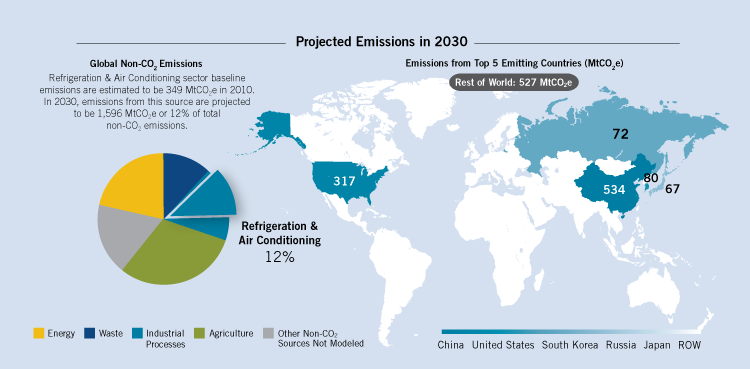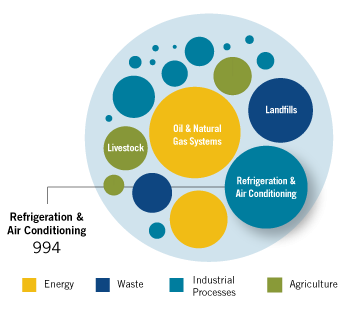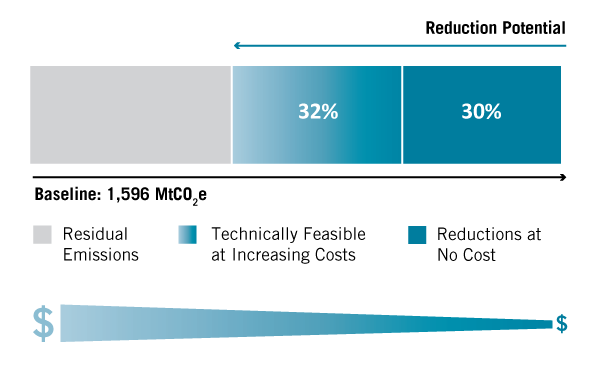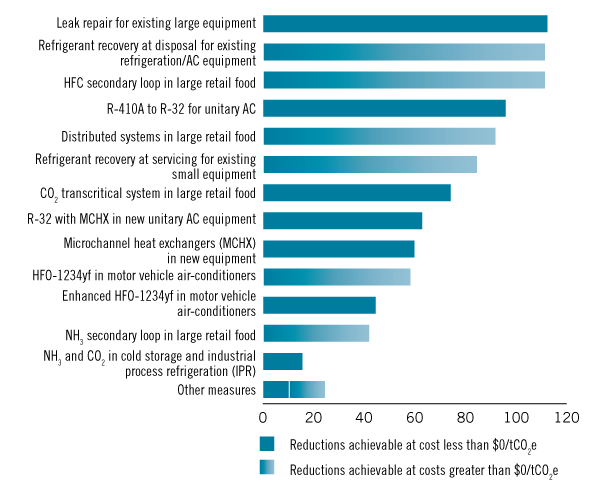Global Mitigation of Non-CO2 Greenhouse Gases: Refrigeration and Air Conditioning
Key Points
- The global abatement potential from the options quantified is 994 million metric tons of carbon dioxide equivalent (MtCO2e), 62% of projected emissions, in 2030.
- 30% of the baseline 2030 emissions can be abated from cost-effective mitigation measures ($0 per tCO2e).
- This sector accounts for the single largest source of non-CO2 abatement potential accounting for over 20% of total abatement potential across all non-CO2 emitting sectors in 2030.
Sector Description
Hydrofluorocarbons (HFCs) used in refrigeration and air conditioning (AC) systems are emitted to the atmosphere during equipment operation, repair, and disposal, unless recovered, recycled, and ultimately destroyed. Equipment is being retrofitted or replaced to use HFCs that are substitutes for ozone-depleting substances. Some of the most common HFCs include HFC-134a, R-404A, R-410A, R-407C, and R-507A.
 View or download the full size image here.(135 K, PNG)
View or download the full size image here.(135 K, PNG)
Emissions Reduction Potential
Assuming full implementation of current technology, emissions in the refrigeration and air conditioning sector could be reduced by up to 994 MtCO2e in 2030. This accounts for 22% of the 4,615 MtCO2e in global reduction potential in 2030.
 View or download the full size image here.(115 K, PNG)
View or download the full size image here.(115 K, PNG)
Abatement Potential
The global abatement potential from refrigeration and AC abatement is calculated to be 994 MtCO2e in 2030, or 62% of baseline emissions; additional uncalculated options are explored qualitatively. The marginal abatement cost curve results show that 479 MtCO2e, 30% of 2030 emissions, can be reduced at a cost of $0 by implementing “no-regret” options. At a cost of $20 per tCO2e, an estimated 910 MtCO2e, or 57% of baseline emissions, could be abated. All abatement options quantified are achievable at mitigation costs below $100/tCO2e.
 It would be cost-effective to reduce emissions by 30%, compared to the baseline, in 2030. An additional 32% reduction is available using technologies with increasingly higher costs.
It would be cost-effective to reduce emissions by 30%, compared to the baseline, in 2030. An additional 32% reduction is available using technologies with increasingly higher costs.
View or download the full size image here.(39 K, PNG)
Abatement Measures
HFC abatement measures are categorized into three categories: 1) retrofit of existing systems to utilize lower GWP refrigerants, 2) new cooling systems to use lower GWP refrigerants and/or reduce the charge size, and 3) better refrigerant management practices that reduce emissions during use, servicing, and disposal. Such options are analyzed for end-uses, including retail food refrigeration systems, window and unitary AC equipment, motor vehicle AC systems, and other types of cooling systems.
 Emissions reductions by technology in 2030 at $0/tCO2e and at higher prices.
Emissions reductions by technology in 2030 at $0/tCO2e and at higher prices.
View or download the full size image here.(61 K, PNG)
